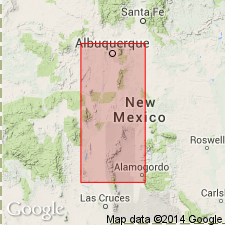
- Usage in publication:
-
- Fresnal group
- Modifications:
-
- Named
- Dominant lithology:
-
- Limestone
- Sandstone
- Conglomerate
- Shale
- AAPG geologic province:
-
- Orogrande basin
- San Juan basin
Summary:
Named upper of two groups of Virgil series--no formational names applied to type locality; Bruton formation (new) named as lower portion of group, limited to Oscura Mountains and region west and north of Oscura Mountains along Rio Grande Valley. Probably named for Fresnal Canyon. Type locality is section measured in Fresnal Canyon along Hwy 83 east of La Luz in north end Sacramento Mountains; exposures in roadcut, NW1/4 sec 30, T15S, R11E, Otero Co, NM, Orogrande basin. Overlies Moya formation of Keller group (both new); underlies Permian (Wolfcamp) limestone unconformably, which is in turn overlain unconformably by Abo formation. In some areas, Abo lies directly on Bruton. Consists of argillaceous to essentially pure limestone, arkosic sandstone, conglomerates, and gray to red shale. Conglomerates at type contain large pebbles of igneous and metamorphic rock --probable source for these thought to have been nearby. In central NM, Fresnal consists largely of red shales, with interbedded thin, nodular to irregularly bedded and highly fossiliferous limestone and arkosic sandstone. On weathered slopes this appears to consist almost entirely of red beds. Highly varied fauna; no mega-fossils studied in detail. Fusulinids are many, of genus TRITICITES, indicating upper Virgil age. Upper part of unit is apparently among youngest stratigraphic portions of Virgil known in North America. Is Pennsylvanian (Virgil) age.
Source: GNU records (USGS DDS-6; Denver GNULEX).
For more information, please contact Nancy Stamm, Geologic Names Committee Secretary.
Asterisk (*) indicates published by U.S. Geological Survey authors.
"No current usage" (†) implies that a name has been abandoned or has fallen into disuse. Former usage and, if known, replacement name given in parentheses ( ).
Slash (/) indicates name conflicts with nomenclatural guidelines (CSN, 1933; ACSN, 1961, 1970; NACSN, 1983, 2005, 2021). May be explained within brackets ([ ]).

